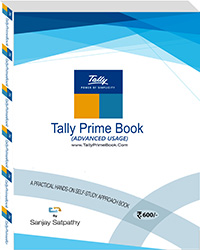Note :
The fields that appear in the Mailing Outstading Ledger screen is briefed below:
‡ E-mail Server: Give the name of your E-mail SMTP server, e.g. mail.btinternet.com. It should be a valid and compatible SMTP server to send your mail. Ask your Internet Service Provider or network administrator for help, if required. This information is entered only once and thereafter use it by default.
‡ From: Your Company name is picked up from the Company Informa- tion Master records.
‡ From E-Mail Address: Your own e-mail address. Tally.ERP 9 picks up the address given in the Company Information master data. Fill this option, if it does not exist.
‡ Format: There are three formats available:
„ ASCII (Comma delimited): This is plain text format where data is separated by commas. This format does not have any special for- matting or fonts. This is the most common e-mail format are com- patible with all mail programs. ASCII data can be easily worked upon by other programs.
„ HTML (Web-publishing): Reports are attractive and retain their formatting and fonts. They can be read by an HTML enabled mail program. It can also be read by using a browser like the Microsoft Internet Explorer.
„ XML (data interchange): Stands for Extensible Mark-up Language, it is an extension of HTML but the data is capable of being imported by other XML compatible systems. Using XML, Tally enables you to exchange information even with non-Tally systems. An XML output will have an XML envelope and is formatted with XML tags to ena- ble import into other systems. Therefore, Your Tally invoice in XML format can be imported by another system without difficulty reduc- ing data entry time and errors. This language is fast emerging as the de-facto standard for information exchange all over the world and with it Tally gives you the means to collaborate with others and share information like never before.
Select the one required by your recipient. An explanation on each format is given below:
‡ Resolution: This is required only in the case of HTML formats and refers to the resolution of graphic images in terms of pixels. This is a feature that is used to format a report since it affects the quality of out- put. Higher resolutions are generally recommended to obtain clear prints. Tally recommends a standard pixel resolution size of 1024x768.
‡ To E-Mail Address (Mandatory field): This is for the recipient's e-mail address. A valid e-mail address is required.
‡ CC: (if any): For sending the same mail to another recipient.
‡ Subject: This is pre-filled for you. This can be changed to any other subject, according to your requirements.
‡ Additional Text: The text in this will appear as the first lines in the message body of the recepient’s mail program. The other options are the same as in Print option and are self-explanatory. |













